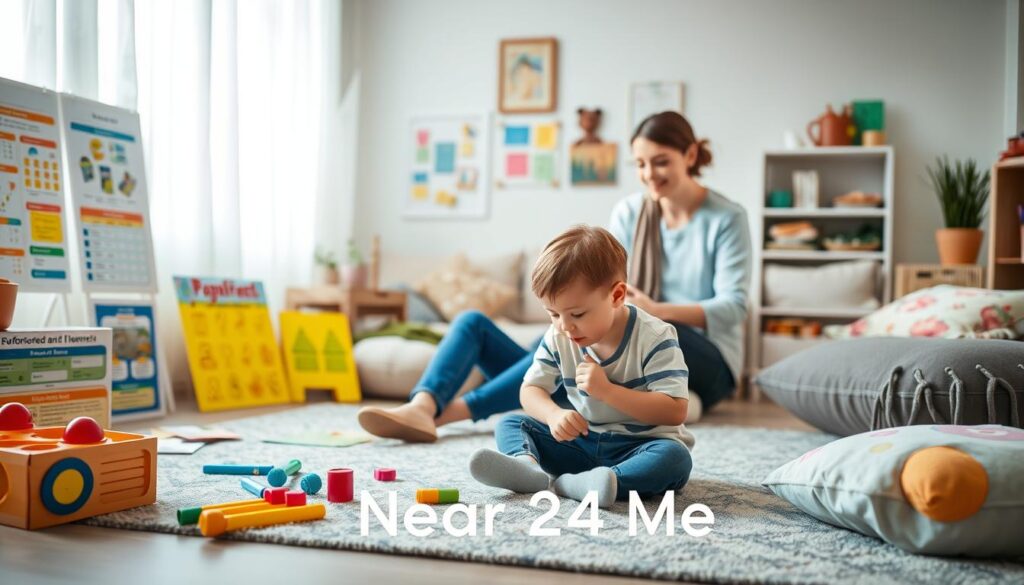“ABA Therapy Near Me ” before reading . Is your child starting Applied Behavior Analysis (ABA) therapy soon? You might wonder how to prepare them for success. Getting ready for ABA therapy can seem daunting, but it’s key for your child’s autism treatment.
ABA therapy is the top choice for kids with autism to learn new skills and manage tough behaviors. Whether it’s at home or in a clinic, getting ready well can really help.
In Florida, thanks to the Autism Insurance Bill, ABA therapy is now more available. It covers up to $36,000 a year for kids who qualify. This includes home therapy, which is cozy and lets families get involved.
As you start this journey, remember you play a big part. You can make the environment right and talk to your child about therapy. Every action you take helps the therapy succeed. Let’s look at how to get your child ready for their ABA therapy sessions.
N.B : if you are facing an issue with birth injury , or someone do , find more tips here about How to Secure Compensation with Birth Injury Lawyers Near You?
Table of Contents
Key Takeaways : ” ABA therapy near me “
- ABA therapy is a proven treatment for children with autism spectrum disorder
- Proper preparation is crucial for successful therapy sessions
- In-home ABA therapy offers benefits like comfort and family involvement
- Creating a conducive environment helps minimize distractions
- Effective communication with your child about therapy is important
- Family participation plays a significant role in generalizing skills
- Understanding insurance coverage can help plan for long-term therapy
Understanding Applied Behavior Analysis (ABA) Therapy
ABA therapy is a well-known treatment for kids with autism and other developmental issues. It teaches important skills like communication and social interaction. This helps them live happy and fulfilling lives.
What is ABA Therapy? : ” ABA therapy near me “
ABA therapy uses positive rewards to teach good behaviors. It starts with an evaluation and then creates a plan for each child. This plan breaks skills into easy steps. Kids get rewards for their progress during practice sessions.
Benefits of ABA Therapy for Children with Autism
ABA therapy has many benefits for kids with autism:
- Improved communication skills
- Enhanced social interaction
- Reduced challenging behaviors
- Increased attention and focus
- Better preparation for school
Research shows that after 12 weeks, almost all kids can ask for help or show their needs.
Evidence-Based Treatment Approach : ” ABA therapy near me “
ABA therapy is supported by scientific studies. It’s not just for autism; it helps with brain injuries and conditions like ADHD and OCD. A team of experts, including psychologists and speech pathologists, work together. They aim to improve positive behaviors and reduce challenging ones.
“ABA therapy aims to increase positive behaviors and reduce challenging ones, helping children with autism spectrum disorder develop crucial life skills.”
Many ABA therapy centers have early intervention programs for kids up to age 6. These programs offer intensive support to help kids build a strong foundation for their future.
The Importance of Preparation for ABA Therapy
Getting ready for ABA therapy is key to making it work well for kids with autism. ABA therapy has been proven to help since the 1960s. It can improve thinking skills, language, and social abilities.
Creating a cozy environment is vital for ABA therapy. It makes everyone feel less stressed and anxious. This makes therapy sessions more effective.
It’s important for parents and caregivers to get involved. Learning ABA techniques helps you support your child at home. This teamwork makes treatment more consistent everywhere.
- Set up a clean, distraction-free space for therapy sessions
- Establish a routine to incorporate therapy into daily schedules
- Communicate openly with your child about what to expect
- Gather essential items like comfort objects and necessary materials
By preparing well for ABA therapy, you help your child grow and develop. Remember, good preparation helps your whole family during therapy.
Creating a Conducive Environment for In-Home ABA Therapy
Setting up the right space is crucial for successful in-home ABA therapy. A well-prepared area helps your child focus and engage during sessions. Let’s explore how to create an ideal setting for effective therapy.
Setting Up a Clean and Flat Surface : ” ABA therapy near me “
A clean, flat surface is key for in-home ABA therapy activities. Choose a sturdy table or desk where your child can work comfortably. Make sure it’s free from clutter and has enough space for materials. This setup allows for better concentration and smoother therapy sessions.
Minimizing Distractions : ” ABA therapy near me “
Reduce distractions to help your child stay focused during therapy. Put away toys and turn off electronic devices not used in the session. A quiet room away from household noise works best. This distraction-free zone improves your child’s ability to learn and practice new skills.
Ensuring a Safe and Non-Threatening Space
Safety is paramount in creating an optimal in-home ABA therapy environment. Remove any hazardous objects from the therapy area. If you have pets, keep them in a separate room during sessions. A safe space allows your child to feel secure and receptive to learning. Remember, a well-prepared environment can significantly enhance your child’s progress in ABA therapy.
“A structured home environment for ABA therapy supports developmental progress and helps children focus on their goals.”
Communicating with Your Child About ABA Therapy

Talking to your child about ABA therapy is crucial for their comfort and success. Explain it as an exciting adventure. Share stories about the new friends they’ll make and the fun activities they’ll do.
Use simple words to describe therapy sessions. You might say, “You’ll play games that help you learn new things.” Let your child know you’ll be there if they need you. This can make therapy seem less scary.
Listen to your child’s questions and concerns. Answer them with patience and care. You could say, “It’s okay to feel nervous. I’ll be here to support you.” This builds trust and makes your child feel more comfortable with ABA therapy.
“ABA therapy has shown improvements in children’s interest in others, communication skills, and focus in academic settings.”
Every child is different. Tailor your explanation to fit your child’s age and understanding. With clear communication and a positive attitude, your child can see ABA therapy as a helpful part of their day.
Establishing a Routine for ABA Therapy Sessions
Creating a consistent ABA therapy routine is key for children with autism spectrum disorder. A well-structured autism treatment schedule helps kids feel secure and enhances therapy effectiveness. Let’s explore how to build a solid foundation for your child’s ABA sessions.
Incorporating Therapy into Daily Schedules : ” ABA therapy near me “
Find a convenient time in your day for ABA therapy sessions. This might be after breakfast or before dinner, depending on your family’s routine. Stick to this time as much as possible. A regular ABA therapy routine helps your child know what to expect each day.
Consistency and Repetition : ” ABA therapy near me “
Repetition is crucial in ABA therapy. Use the same structure for each session. Start with a greeting, move through planned activities, and end with a goodbye ritual. This pattern creates a predictable environment where your child can focus on learning and skill development.
A study by Williams and Davis in the Journal of Autism and Developmental Disorders found that structured ABA sessions lead to better learning outcomes. They suggest breaking sessions into clear segments:
- Warm-up activity
- Skill practice
- Break time
- New skill introduction
- Wrap-up and reward
Remember, flexibility within your autism treatment schedule is important too. Garcia and Martinez’s research showed that incorporating breaks and variety into ABA sessions can boost engagement and learning. Adjust your routine as needed, but always maintain core elements to provide stability for your child.
Involving Family Members in the ABA Therapy Process
Family involvement in ABA therapy is key to a child’s success. When family members join therapy sessions, they learn a lot about their child’s needs. They also learn how to communicate better.
Grandparents and siblings can help a lot by practicing skills at home. This teamwork makes the child’s home environment more supportive. It helps the child grow and develop better.
ABA therapy sessions work on important daily issues. These include:
- Rule-following
- Sharing
- Communication skills
- Identifying triggers
By taking part in these sessions, family members learn to use ABA techniques everywhere. This includes home, school, and community settings.
| Setting | Focus Areas | Family Involvement |
|---|---|---|
| Home | Daily routines, self-help skills | Practicing skills, reinforcing behaviors |
| School | Academic skills, social interactions | Collaborating with teachers, supporting homework |
| Community | Social skills, independence | Generalizing skills, promoting inclusion |
By getting involved in ABA therapy, parents and caregivers become vital partners. This teamwork ensures therapy works well in all parts of the child’s life.
Preparing Essential Items for ABA Therapy Sessions
Getting ready for ABA therapy is more than just scheduling. It’s about setting up the right environment and having the right materials. This preparation can make your child’s experience better and the therapy more effective.
Comfort Objects and Favorite Toys : ” ABA therapy near me “
Include items that make your child feel safe. This could be a favorite stuffed animal, a special blanket, or a preferred toy. These items help your child feel secure during therapy.
Snacks and Drinks : ” ABA therapy near me “
Have some healthy snacks and drinks ready. They can be rewards or help keep your child’s energy up during long sessions. Always talk about any food allergies with your therapist.
Necessary Materials for Activities : ” ABA therapy near me “
Work with your therapist to find out what materials you’ll need for activities. This might include:
- Coloring supplies
- Puzzles
- Building blocks
- Picture cards
- Educational toys
Having these items ready can make therapy sessions smoother and more productive. The goal is to make the experience positive and engaging for your child. It also supports their progress in autism treatment.
“Preparation is key to successful ABA therapy sessions. Having the right materials on hand can make a world of difference in your child’s engagement and progress.”
ABA Therapy Near Me: Finding the Right Provider
Finding the right ABA therapy providers is crucial for families with autism. In the U.S., 1 in 54 kids have autism. When searching for “ABA therapy near me,” consider several key factors for the best care for your child.

Look for autism treatment centers with board-certified behavior analysts (BCBAs). These experts create therapy plans that fit your child’s needs. ABA therapy can be intense, from 6 to 40 hours a week, based on your child’s needs.
When checking providers, ask about their experience with autism and their treatment approach. Choose centers that focus on families and have a history of success. They should help your child improve in communication, social skills, and self-care.
Also, see if the provider offers therapy in different places, like at home or in clinics. This flexibility is important for your child’s progress and your family’s ease. Ask about programs for parents too, as your support is vital for your child’s success.
- Verify the therapist’s credentials and experience
- Ask about their specific ABA techniques and treatment plans
- Inquire about parent involvement and training opportunities
- Check if they offer flexible therapy settings
- Confirm insurance coverage and session frequency options
By doing your research and asking the right questions, you’ll find a top-notch ABA therapy provider. This can greatly improve your child’s development and your family’s life.
Collaborating with ABA Therapists
Working with ABA therapists is crucial for your child’s autism treatment. Good communication is key to making therapy fit your child’s needs and your family’s goals. Let’s look at how to build a strong partnership with your ABA therapy team.
Sharing Information About Your Child : ” ABA therapy near me “
Your knowledge about your child is very important. Share what they like, dislike, and what triggers them. This helps therapists make plans that are just right for your child. For instance, if they love trains, the therapist might use train activities to teach new skills.
Discussing Goals and Expectations : ” ABA therapy near me “
Setting clear goals is essential in autism treatment. Work with your therapist to set achievable targets. These could be improving communication, social skills, or self-care. Regular meetings help keep everyone on the same path.
| Goal Area | Example Target | Progress Tracking |
|---|---|---|
| Communication | Use 3-word sentences | Weekly word count |
| Social Skills | Take turns in games | Daily behavior chart |
| Self-Care | Brush teeth independently | Morning routine checklist |
Your role is crucial in ABA therapy success. By being involved, you help create a supportive environment for your child’s growth.
Addressing Potential Challenges in ABA Therapy

” ABA therapy near me “
ABA therapy can face challenges when helping children with autism. Spotting these issues early is key. This way, families and therapists can team up to find solutions. Let’s look at common problems and how to solve them.
Switching between activities can be tough for kids with autism. Slowly introducing new routines helps. Visual schedules or timers can also help kids know what’s next. This reduces their anxiety and makes them more willing to adapt.
Another problem is when kids don’t use skills learned in therapy at home. Encouraging families to practice these skills at home helps a lot. This ensures that therapy benefits last beyond the session.
- Use positive reinforcement consistently
- Implement gradual changes to routines
- Create a supportive environment at home
- Collaborate closely with ABA therapists
Sensory issues can also slow down progress. ABA therapists aim to find what causes problems and teach coping skills. This might mean making a special space or using headphones to block out noise.
| Challenge | Strategy |
|---|---|
| Difficulty with transitions | Use visual schedules |
| Inconsistent skill application | Practice at home |
| Sensory sensitivities | Create sensory-friendly spaces |
| Resistance to new activities | Introduce changes gradually |
By tackling these challenges together, families and therapists can improve therapy outcomes. This teamwork leads to better lives for kids with autism.
Conclusion : ” ABA therapy near me “
ABA therapy helps kids with autism by teaching new skills and reducing bad behaviors. The success of treatment depends on good preparation and family support. It’s important to create a supportive home environment and keep therapy consistent.
Early treatment is crucial, with many ABA therapy providers in the U.S. Parents should look for certified professionals with ASD experience. Companies like Supportive Care ABA and Total Care ABA Therapy offer customized services for each child.
The amount and intensity of ABA therapy vary by child. Focused therapy might be 10-15 hours a week for two years. More comprehensive programs could need 25-40 hours weekly for at least two years. Working closely with therapists and keeping in touch helps families support their children’s growth and success.








7 thoughts on “How to Prepare Your Child for ABA Therapy Sessions ?”